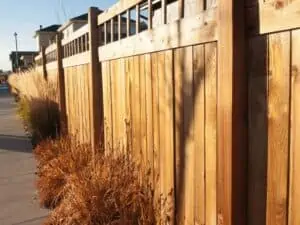How to Build a Board-on-Board Cedar Fence?
Adding a fence to your property can be beneficial for privacy and security. It can also help to define your property boundaries and prevent unwanted visitors from entering. Whether you’re looking to protect your children and pets, or you just want to add a touch of curb appeal to your home, building a board-on-board cedar fence can be an excellent choice.
(Looking for a residential chain link fence? Contact us today!)

A board-on-board fence is a type of fencing that relies on an overlapping pattern. This alternating pattern of boards allows the fence to look attractive on both sides, while still providing a strong level of privacy.
This style of fence is usually made from redwood or cedar and is a great option for homeowners who want to add a little privacy to their yards. They are durable and easy to maintain and can be stained and finished to suit your taste.
When choosing the materials for your fence, be sure to take your geographic location and budget into account. If you live in a rainy area, then you might want to choose cedar because it is resistant to rot and moisture. Cedar also resists insect damage, making it ideal for your fence.
Before you begin, measure and mark the location of your posts. This is a crucial step because you need to know where to dig the holes. Normally, posts should be at least 6 feet apart. You can use string lines to help you determine the correct distance.
Install the Posts
After you’ve dug the holes and staked them in place, use a concrete mix to create the posts. These posts should be sunk at least one-third of the way into the ground to prevent them from sagging in high winds or heavy rains. Be sure to place a gravel or sand mixture in the bottom of the hole, and slope the top away from the post for proper drainage.
Installing the Pickets
Once you’ve installed the posts, you can then start installing the pickets on top of them. This is a quick and easy way to build your fence, but it’s important to ensure that the boards are properly spaced. If the boards are not correctly spaced, they can warp or split.
To ensure your fence is sturdy, be sure to fasten the pickets in place using galvanized or stainless steel fence nails. Most have a round head, which is designed to fit tightly into the wood, and have a shank that is twisted or ribbed. This irregularity in the shank helps to prevent the boards from splitting when nailed or screwed together.
The most popular material for a board-on-board fence is cedar, because of its soft nature and its ability to accept both stains and finishes. It is also a great choice for homes in the Pacific Northwest because it is weather resistant and can handle moisture well.

